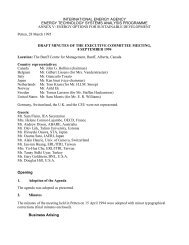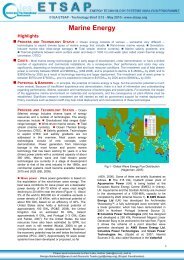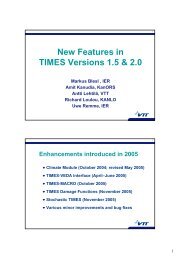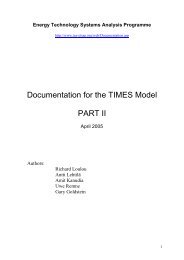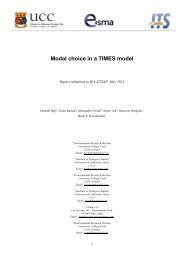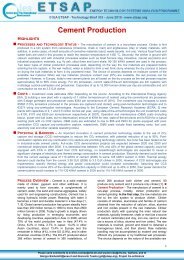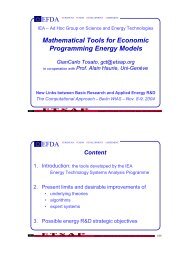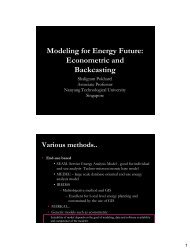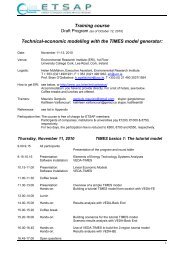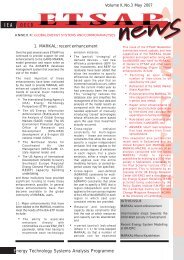Documentation for the MARKAL Family of Models - iea-etsap
Documentation for the MARKAL Family of Models - iea-etsap
Documentation for the MARKAL Family of Models - iea-etsap
Create successful ePaper yourself
Turn your PDF publications into a flip-book with our unique Google optimized e-Paper software.
3.3 Calibration and o<strong>the</strong>r modeling issues<br />
This section provides some indications on <strong>the</strong> estimation <strong>of</strong> some parameters, mostly<br />
related to <strong>the</strong> MACRO module. The <strong>MARKAL</strong> calibration is done independently using<br />
energy statistics.<br />
First <strong>of</strong> all, most MACRO variables are equal to standard macroeconomic statistics in <strong>the</strong><br />
initial year, namely: Consumption (C 1 ), Production (Y 1 ), Investments (INV 1 ), Capital<br />
(K 1 ). Labor index at time 0 is set to 1. The initial year’s energy cost should be taken equal<br />
to <strong>the</strong> <strong>MARKAL</strong> annual energy cost at initial period, augmented by <strong>the</strong> annualized<br />
capital cost <strong>of</strong> residual capacities (which are not counted in <strong>MARKAL</strong>).<br />
We now discuss <strong>the</strong> benchmarking <strong>of</strong> <strong>the</strong> parameters appearing in <strong>the</strong> equations.<br />
3.3.1 Production Function Parameters<br />
The value <strong>of</strong> ρ is directly obtained from ρ = 1 − (1/ esub)<br />
. The latter parameter cannot be<br />
found directly, first <strong>of</strong> all because it relates to <strong>the</strong> elasticity <strong>of</strong> energy demand services, and<br />
<strong>the</strong>ir quantities and prices are not available from statistics, unlike final energy uses.<br />
Secondly, it is an aggregate governing <strong>the</strong> reaction <strong>of</strong> all demands to changes in <strong>the</strong>ir prices<br />
and <strong>the</strong>reby necessarily a compromise. It is recommended to vary esub and analyze <strong>the</strong><br />
results be<strong>for</strong>e deciding on a 'best guess'. Realistic ranges are thought to be between 0.2 and<br />
0.5. The higher end estimates are more appropriate <strong>for</strong> models in which end-use demand<br />
sectors are modelled in <strong>MARKAL</strong> with little detail and/or have limited opportunities <strong>for</strong><br />
energy conservation or substitution. In that case <strong>the</strong> technological response to higher prices<br />
inside <strong>MARKAL</strong> is relatively small, and <strong>the</strong> econometric response should contribute more<br />
to <strong>the</strong> overall demand reaction. Vice versa, if a large number <strong>of</strong> technological response<br />
options are present in <strong>MARKAL</strong>, esub should be at <strong>the</strong> lower end so as not to overestimate<br />
<strong>the</strong> combined demand response.<br />
Parameters akl and b dm may be determined using base year statistics, via <strong>the</strong> following<br />
two-step procedure:<br />
- First, <strong>the</strong> reference price <strong>of</strong> energy service dm is equated to <strong>the</strong> partial derivative <strong>of</strong> Y t<br />
w.r.t. to D dm , yielding:<br />
∂Y<br />
/ ∂D<br />
1−ρ<br />
dm<br />
= pref<br />
t<br />
dm<br />
= Y D<br />
=<br />
,0<br />
(<br />
0<br />
/<br />
0 dm,0)<br />
⋅ b<br />
dm<br />
thus allowing <strong>the</strong> computation <strong>of</strong> b dm , <strong>for</strong> all dm.<br />
Next, <strong>the</strong> expression <strong>of</strong> <strong>the</strong> production function in base year is used to directly compute<br />
akl.<br />
393




